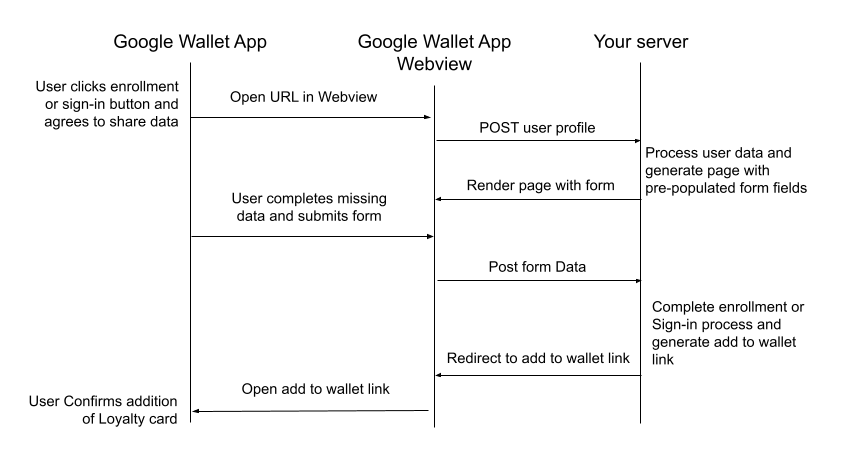借助会员注册和登录功能,用户可以搜索您的 会员回馈活动,并通过 Google 钱包加入或登录其账号。 系统会将用户定向到您的适合移动设备浏览的网站,以完成 之后,用户就可以将自己的银行卡添加到 Google 钱包了。
本指南概述了所需的实现步骤。 为您的会员回馈活动启用此功能。
概览
首先,请确保您之前已设置好项目,并且有权访问 Google Wallet API。
您必须按照以下四个步骤来实现注册和登录功能 为您的会员回馈活动:
- 在 Google 钱包中设置测试类,用于测试您的注册/登录流程。
- 开发使用 Google 电子钱包
SharedDataType的注册/登录页面。 - 在注册/登录后将会员卡推回 Google 钱包。
- 请求验证和激活。
在 Google 钱包中设置测试类
确定注册和登录网址、您的计划徽标和选定的用户字段。然后,
使用 discoverableProgram 嵌套字段,
loyaltyclass,用于设置
适当的值
在 discoverableProgram 中设置值,以创建您的
启用了注册/登录的会员回馈活动。为确保测试人员可以看到此信息,请确认
测试人员可以访问您的 Google Pay 和钱包控制台。如需详细了解如何将您的
有关 Google Pay 和钱包控制台的访问权限,请参阅
了解“用户”页面。
为了在开发期间完成实现功能的验证 流程,请通过 Google Pay 和钱包控制台中的“联系支持”微件与我们联系。在 在控制台中选择 Google Wallet API,然后在以下位置选择会员登录/注册: 子主题。
开发使用 Google 钱包用户数据的注册和登录页面
当用户选择登录或注册参加您的会员回馈活动时, 他们就会被定向到您网站上的专门定制页面 注册或登录流程。如果用户选择注册 Google 电子钱包 会请求用户批准与您共享其用户数据。
您需要提供两个页面之一或两个页面,以便用户完成这些操作。
- 一个登录网址,用户可通过该网址登录现有账号。
- 可供用户创建新账号的注册网址。
您的登录和注册页面必须符合以下要求:
- 提供适合移动设备的用户体验。
- 请尽量减少注册过程中的必填字段数量。
- 允许用户在一个页面中完成登录或注册。
- 结合使用
HTTPS加密与有效证书,确保用户数据 安全传输的内容 - 确保登录和注册页面的正常运行时间至少达到 99.9%。
除了上述要求之外,我们还建议您允许用户 即可注册您的会员回馈活动,无需填写任何表单或 仅保留页面以让您接受服务条款。
- 您可以利用
SharedDataType中提供的用户数据创建账号 然后立即推回他们的会员卡。 - 您随后可以通过电子邮件向用户发送动态密码或链接 来配置密码和可选的账号详情。
- 这样可以降低用户放弃注册流程的几率 因为每增加一个步骤都会导致更多次流失。
在显示登录或注册页面时,Google 电子钱包会创建
Android WebView 和 POST 请求会发送到您提供的
网址。用户数据在参数 SharedDataType 中提供
它包含在 POST 请求之中,使用
<ph type="x-smartling-placeholder"></ph>
application/x-www-form-urlencoded 内容类型和
UTF-8 编码。SharedDataType 的值
参数是一个 Base64 编码的 JSON 对象。
取决于用户选择的操作和您指定的字段 JSON 对象可能包含以下字段。
| 字段 | 注册 |
|---|---|
| 电子邮件 | ✓ |
| firstName | ✓ |
| lastName | ✓ |
| 地址行 [1-3] | ✓ |
| city | ✓ |
| 州 | ✓ |
| zipcode | ✓ |
| country | ✓ |
| 电话 | ✓ |
请参阅以下已解码的 JSON 对象示例
包含在 SharedDataType 中。
资源
{ "firstName": "Jane", "lastName": "Doe", "addressLine1": "1600 Amphitheatre Pkwy", "addressLine2": "Apt 123", "addressLine3": "Attn:Jane", "city": "Mountain View", "state": "CA", "zipcode": "94043", "country": "US", "email": "jane.doe@example.com", "phone": "555-555-5555" }
立即将会员卡推回 Google 钱包
通过身份验证(登录)或创建账号(注册)后, 应立即将用户的会员卡推回 Google 钱包。
您可以将会员卡重定向至 Google 钱包,将会员卡推回 Google 钱包。 链接。
https://pay.google.com/gp/v/save/{jwt_generated}网址的安全长度为 2000 个字符。您的链接应 也低于此限制编码到 JWT 中的对象要小,只包含 用户特有的数据尽量将大部分数据放在对象的类中, 然后再创建 JWT。对于不符合长度限制的较大对象,请考虑 首先在 Cloud Shell 中 Google Wallet API 且仅发送 JWT 中的对象 ID。
典型的通信流程
完成注册或登录的用户的通信流程如 以下图片。“您的服务器”之间的所有操作您需要自行负责实现

请求验证和激活
完成开发工作并测试注册/登录流程后,请提交请求 通过 与 Google Pay 和钱包控制台支持团队联系 微件。
在对您的实现进行全面审核以确认 与 Google 钱包应用结合使用时,会员注册/登录功能将 。这样,任何用户都可以看到 以及如何利用这些功能
为了确保最佳用户体验,系统会定期检查您的注册/登录情况 开展实施工作,确保始终符合功能要求。 如果出现差异以及登录/注册功能,您会收到通知 在问题得到解决之前可能会被停用。
常见问题解答
- 我的会员回馈活动中使用的图片是否有任何要求?
- 是的,您的图片应托管在
HTTPS个位置 否则它们将不会显示在 Google 钱包中。
- 是的,您的图片应托管在
- 是否有任何工具可以简化 JWT 的实现和调试?
- 是,诸如 www.jwt.io 并在开发过程中调试令牌,让您可以验证 提交的内容。请注意,Google 没有联属关系,也不 特别推荐此类第三方。
- 如何正确处理 Base64 编码的 SharedDataType 数据?
- 确保您在整个流程中使用的是 UTF-8 编码。JSON 字符串 先采用 UTF-8 编码,然后使用 <ph type="x-smartling-placeholder"></ph> android.util.Base64(其中包含 NO_WRAP 和 网址_SAFE 选项)。这对应于 RFC 3548 第 4 节。

